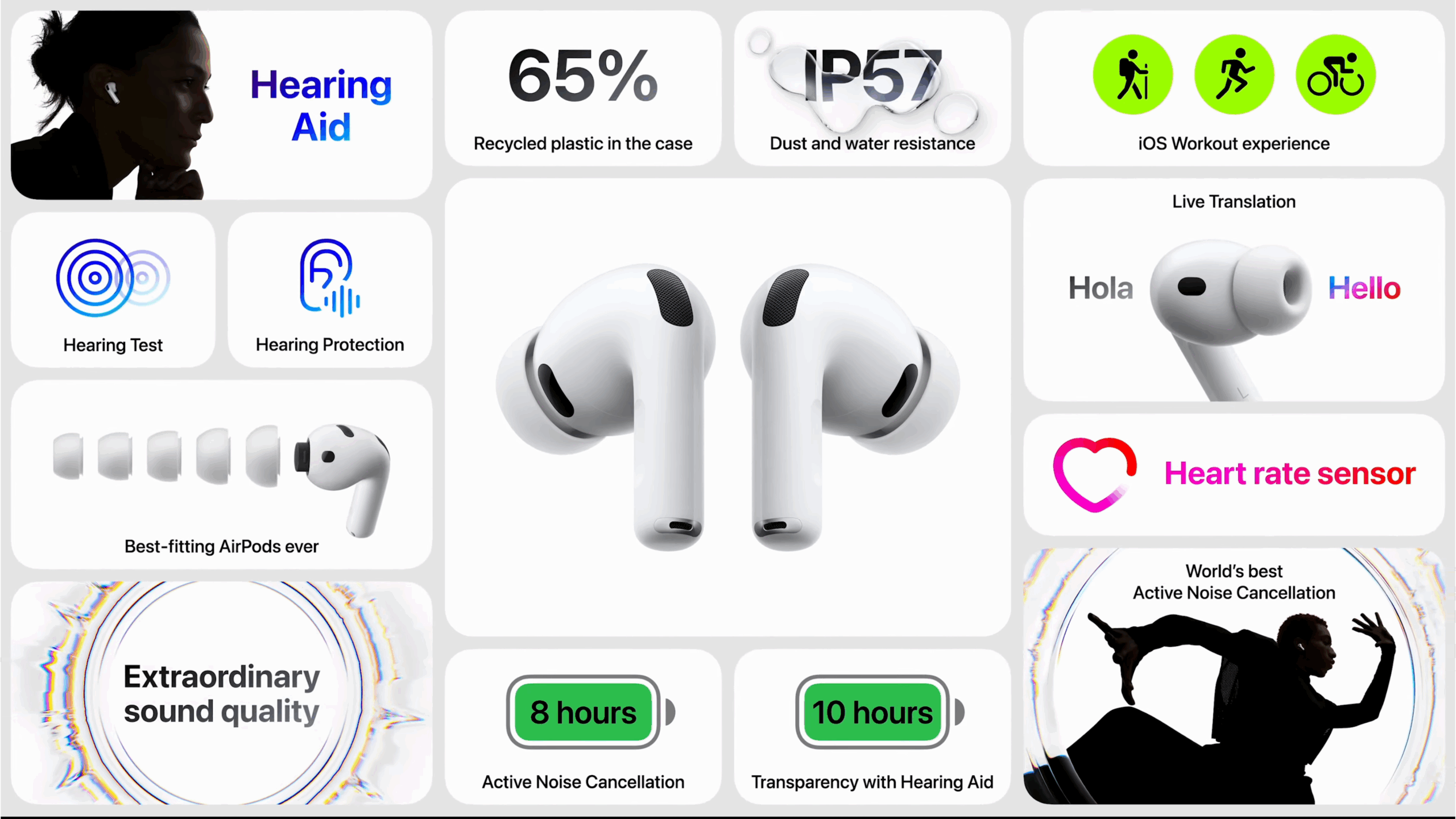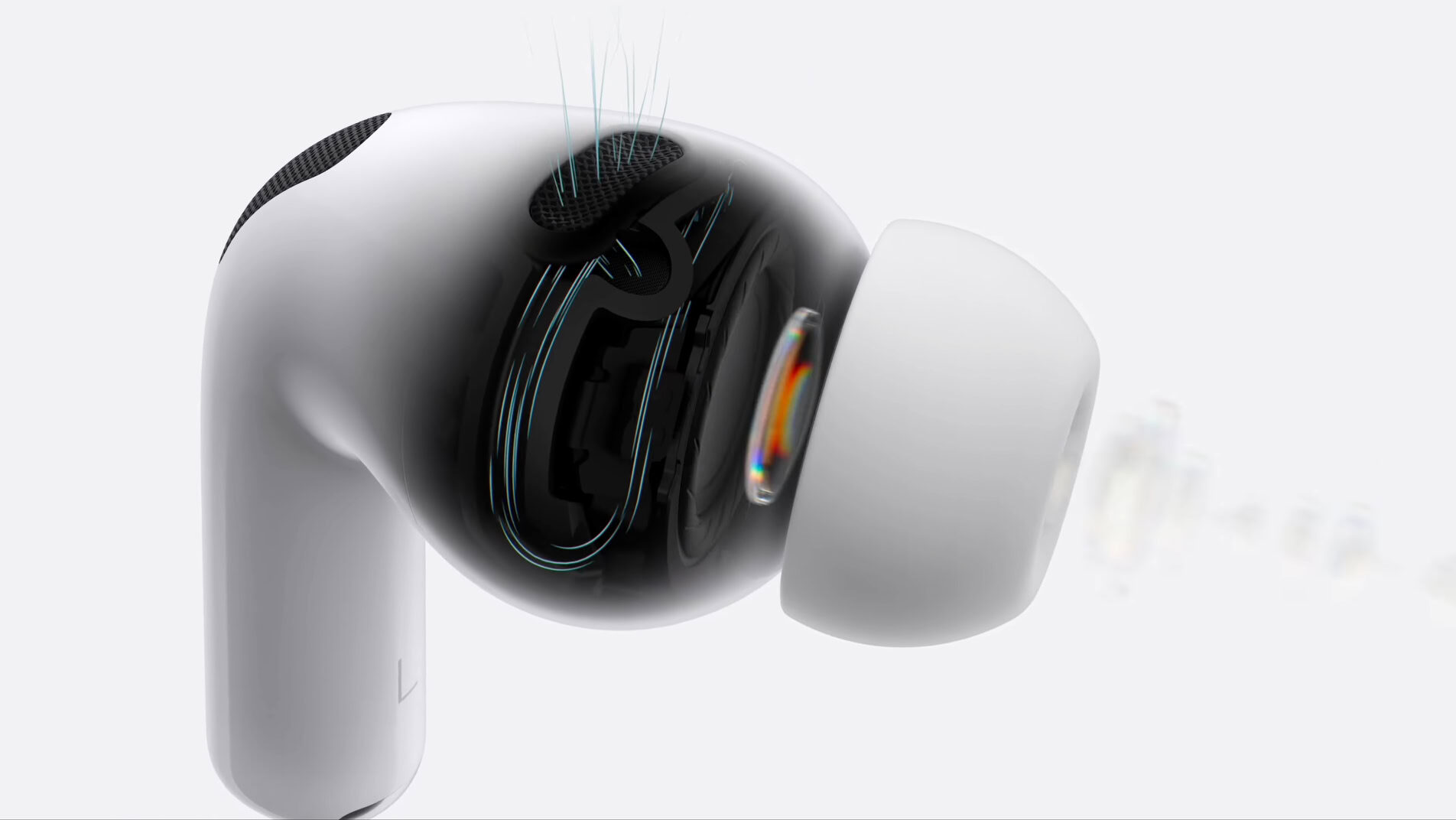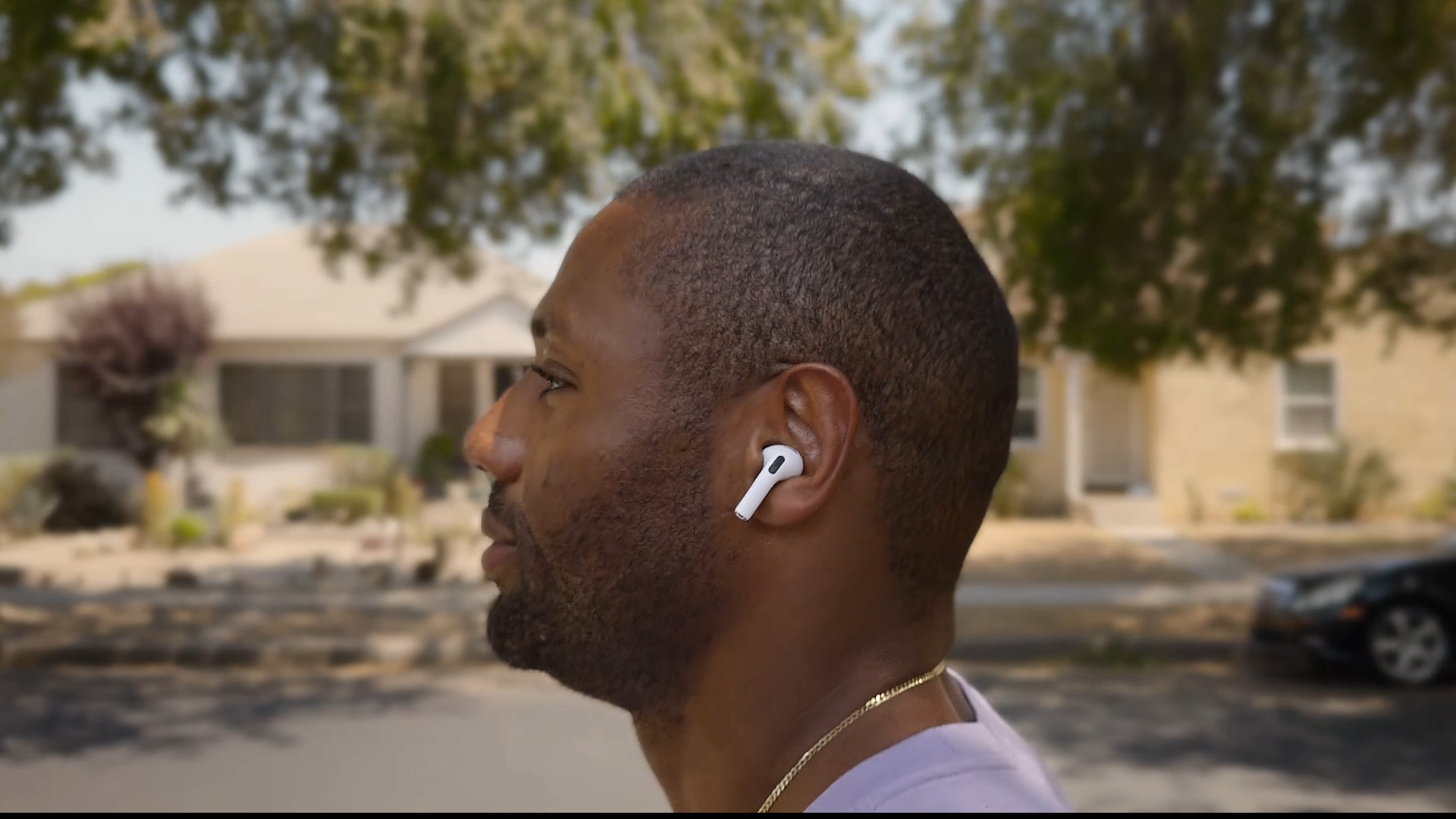All products featured are independently chosen by us. However, SoundGuys may receive a commission on orders placed through its retail links. See our ethics statement.
Decoding Apple's marketing jargon on the AirPods Pro 3
9 hours ago

We live in a time where marketing bullshit has evolved into a science, with companies spending millions to workshop buzzwords to make you feel a certain way. For instance, Apple called their latest event ‘awe-dropping’, a made-up term that perfectly captures how tech companies say things that sound impressive but mean nothing concrete. Throughout the presentation, Apple layered on more marketing speak: ‘breakthrough audio performance,’ ‘truly magical user experience,’ and other glossy phrases designed to sound revolutionary. But what do these phrases actually mean? Let’s cut through Apple’s marketing fluff and break down what the AirPods Pro 3 claims actually mean for everyday users.
“Breathtaking spatial listening”

Apple promises a “breathtaking spatial listening experience” thanks to their “custom, multi-port acoustic architecture” that “precisely controls airflow” and “transforms the bass response.” Sounds impressive, right?
- Marketing translation: More bass = better sound
- Fact check: not necessarily true
Here’s what we gather this actually means: Apple likely redesigned the bass ports on the AirPods Pro 2. While this can improve sound quality, bass ports aren’t revolutionary—they’re standard features found in subwoofers and most wireless earbuds.
The bigger issue is Apple’s confused terminology. They claim this bass improvement “widens the soundstage” and brings “vocals into stunning focus.” But bass typically has little to do with soundstage, which is itself a bit of a catch-all buzzword for the expansiveness of sound. We here at SoundGuys and most audio engineers use the term stereo imaging instead, so that we can talk about specific qualities like spatial width and depth. And the perceived increase of spatial width and depth is normally associated with an increase or decrease in the mids or treble, not bass.
By “stunning vocals,” Apple could be talking about detail and separation. The problem is that increasing bass usually creates a compressed or muffled sound. Depending on the tuning, vocals can tend to sound like someone is shouting at you even when you dial down the volume. Apple’s marketing seems to promise contradictory improvements that don’t align with basic audio engineering principles.
What does “2X” the ANC even mean?

Apple claims its AirPods Pro 3 deliver “2x the Active Noise Cancellation” thanks to “ultra low-noise microphones and advanced computational audio” combined with “new foam-infused ear tips for even greater noise isolation.”
- Marketing translation: Active Noise Cancellation and passive isolation have been improved compared to previous models.
- Fact check: Generally, newer models are better than older models as technology improves. Yikes if not.
This is a fancy way of saying they improved both active noise cancellation tech and passive isolation via the eartips, with the latter likely doing most of the heavy lifting. Foam-infused ear tips aren’t revolutionary—Sony already uses them in its XM5 earbuds and INZONE gaming IEMs—but they’re becoming standard across the industry because they better conform to ear shapes.
However, the math doesn’t add up regarding the multiplication claims. Apple throws around statements like “twice the ANC” and “four times more effective” but provides zero actual data. There are no decibel measurements or frequency response graphs to show specific reductions, just giant “2X” and “4X” graphics. As such, we have no idea which types of sounds are reduced or by how much. Apple is likely combining its ANC improvements with better passive isolation to reach that “2X” claim. But that doesn’t magically become “four times more effective” compared to the original AirPods Pro, as they suddenly claim without explanation.
Can Apple actually deliver the “world’s best” ANC? Currently, the Jabra Elite 10 Active (2nd Gen) holds that title with an average noise reduction of 86% in our lab tests, compared to 83% for the AirPods Pro 2. Those few percentage points are incredibly hard to improve. The foam ear tips alone could potentially bridge that gap, giving Apple a legitimate shot at the crown—but we’ll need to test them in our lab to verify these bold claims.
“Voices sound more natural than ever.”

Apple promises to have improved transparency mode so that “your own voice and people speaking to you will sound more natural than ever.”
- Marketing translation: Transparency mode has been improved.
- Fact check: Potentially only an incremental refinement dressed up as a huge leap in features.
Perhaps Apple has added “side tone” functionality, where the microphone captures and plays back your own voice so you don’t sound muffled to yourself. This prevents the common problem of shouting louder and louder because you can’t hear yourself while having your ears blocked by earbuds. It’s a useful feature, but hardly groundbreaking technology.
The “people speaking to you” part refers to what Apple calls “conversation boost,” a feature that reduces ambient noise while focusing on speech. However, conversation boost already exists on the AirPods Pro 2, so Apple is essentially promising to improve a feature they already have.
To be fair, Apple already has one of the best transparency modes available, with only minor unnatural qualities in the current AirPods Pro 2. An improvement would be welcome, but Apple would just be beating itself at this point. Without specific technical details about what’s actually changed, this sounds like incremental refinement dressed up as advancement.
What do 10,000 ear scans actually mean for your ears?

Apple claims they used “more than ten thousand 3D ear scans along with over one hundred thousand hours of user research” to optimize the AirPods Pro 3 fit.
- Marketing translation: Apple did a lot of research on earbud fit.
- Fact check: A larger sample size typically leads to a better average fit.
These are impressive numbers, but they’re also classic marketing fluff. Yes, a larger sample size typically leads to better average fit, but quantity doesn’t guarantee quality. Plenty of companies put in excessive hours only to deliver mediocre results. Apple isn’t immune to this – we won’t know if all that research actually translates to a better fit until people have them in their ears.
Apple had made similar claims with their AirPods 4 lineup last year, saying they “precisely mapped and analyzed thousands of ear shapes, generating over 50 million individual data points,” to “create our most comfortable AirPods ever.”. However, for most people, this did not significantly improve the fit of the earbuds, with users saying they stay better in their ears, but not by much. If you’re having issues with the fit of the AirPods Pro 2, chances are the AirPods Pro 3 will only be a slight improvement.
The biggest change that improves fit is the inclusion of five eartip sizes instead of three. Users also found that using foam eartips significantly improved the grip of the AirPods Pro 2. This means that it’s likely the “new foam-infused ear tips” could lead to increased grip, preventing the earbuds from falling out. However, the foam seems to be on the inside of the eartip. Again, we’ll see if this is the case when we have them on hand.
The IP57 rating is more concrete. Apple upgraded from the AirPods Pro 2’s IPX4 rating, which is actually significant. The “5” means near-perfect dust resistance (though some dust can still enter – IP6X would be completely dustproof). The “7” means you can submerge them in one meter of water for 30 minutes, a major upgrade from basic sweat resistance.
However, IP ratings aren’t cumulative at higher levels, so while they can handle full submersion, they might not handle high-pressure water jets. Not that you’re likely to encounter that while wearing AirPods. Still, the previous AirPods Pro 2 are only IPX4 rated, which means that the AirPods Pro 3 are getting a significant bump in durability.
“Innovative fitness capabilities”

Apple promises “machine learning algorithms fuse together data from the sensors and accelerometers to deliver precise measurements.”
- Marketing translation: Transparency mode has been improved.
- Fact check: Potentially only an incremental refinement dressed up as a huge leap in features.
Translation: They’re using math equations to estimate fitness data – what engineers used to simply call algorithms before “machine learning” became a marketing buzzword. The real issue? Apple never defines what “precise measurements” actually mean. Engineers work with something called “tolerance” – the acceptable margin of error, which can range from 10% to 0.01% depending on the application. For fitness tracking, a close average is usually good enough, but Apple doesn’t specify its standards.
The API claim is developer marketing speak. When Apple mentions “new APIs to incorporate key metrics,” they’re targeting iPhone app developers. APIs (Application Programming Interfaces) essentially mean the AirPods’ health data should work with third-party fitness apps, not just Apple’s built-in fitness app.
This sounds useful in theory, but Apple has a notorious track record of being difficult to work with on the developer side. Many developers struggle to get app updates approved, so whether these APIs will actually result in widespread third-party integration remains to be seen.
Why do we need all the fancy marketing jargon?

If you’ve reached this far, you probably know why fancy marketing jargon exists. It’s the attempt to signal to the audience that whatever they’re selling is a good thing, without the dissertation that you had to read above. It’s about invoking the feeling of making a good choice by making the purchase. Personally, I could use less of the marketing jargon trying invoke the feeling of what the purchase could do for me. A lot of marketing these days tends to magnify a small problem and then present a solution that happens to be the greatest thing ever. The AirPods Pro 3 are a nice quality-of-life improvement to the overall experience of hearing music; that’s it.
The AirPods Pro 3, I don’t believe, will “take the audio quality of the most popular headphones in the world to an entirely new level.“. Will it be better than the AirPods Pro 2? I would hope so. Is it going to be worth the upgrade? I don’t think so. When a new version of a product launches, chances are it’s going to be better than the old one. But that doesn’t make the old one obsolete. The old one didn’t suddenly become worse. It’s only that newer and better experiences now exist.
It’s time companies dropped the marketing theater and explained what their products actually do. Do you agree, or are you fine with people on stages using flowery language and vague terminology to hype and sell their products?
How do you want companies to market their products?
Thank you for being part of our community. Read our Comment Policy before posting.